Frogs in Myth & Legend (and the Leap into Books Giveaway Hop!)
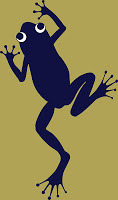 LEAP DAY (Feb. 29) is a natural time to talk about FROGS (well, it seemed like it to me, LOL). Research turned up some great myths, legends and stories about these creatures. But my own fascination with frogs and toads began when my Welsh grandmother gave me a ceramic frog for my apartment when I left home. She told me that I should always have a frog in the house for good luck.
LEAP DAY (Feb. 29) is a natural time to talk about FROGS (well, it seemed like it to me, LOL). Research turned up some great myths, legends and stories about these creatures. But my own fascination with frogs and toads began when my Welsh grandmother gave me a ceramic frog for my apartment when I left home. She told me that I should always have a frog in the house for good luck. Stone frog in gardenTurns out that the ancient Romans thought house frogs were lucky too, and kept live frogs as mascots. Many cultures consider it a sign that money is coming to you if a frog enters the house. Finding a frog outside is lucky too, and if frogs live in your garden, good fortune will come to the house and all its occupants. In Scotland today, frogs have been considered lucky since Celtic times and there are often stone frogs kept in the garden. Frog figurines have traditionally been given as housewarming gifts there and in many other parts of the UK as well.
Stone frog in gardenTurns out that the ancient Romans thought house frogs were lucky too, and kept live frogs as mascots. Many cultures consider it a sign that money is coming to you if a frog enters the house. Finding a frog outside is lucky too, and if frogs live in your garden, good fortune will come to the house and all its occupants. In Scotland today, frogs have been considered lucky since Celtic times and there are often stone frogs kept in the garden. Frog figurines have traditionally been given as housewarming gifts there and in many other parts of the UK as well.
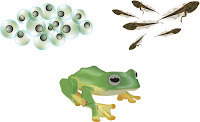 The Amazing Life Cycle of a FrogBoth the Egyptians and Greeks believed frogs possessed a creative force – they were symbols of inspiration (as a writer, maybe I need more frogs…) and many cultures equate them with great transformative powers and even reincarnation. After all, frogs and toads are every bit as amazing as butterflies. They go through vastly different phases in their lives – from eggs they hatch into gilled tadpoles that can only live underwater, and then gradually transform to air-breathing land creatures. It's not surprising that frogs are also associated with personal growth and achievement.
The Amazing Life Cycle of a FrogBoth the Egyptians and Greeks believed frogs possessed a creative force – they were symbols of inspiration (as a writer, maybe I need more frogs…) and many cultures equate them with great transformative powers and even reincarnation. After all, frogs and toads are every bit as amazing as butterflies. They go through vastly different phases in their lives – from eggs they hatch into gilled tadpoles that can only live underwater, and then gradually transform to air-breathing land creatures. It's not surprising that frogs are also associated with personal growth and achievement.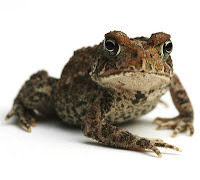 A common toadThe ultimate achievement is shown in an old story about a toad who had fallen in love with the moon and wanted to go there more than anything. Everyone told the toad that it was impossible to leap so high. But the toad decided not to listen and began jumping. Each time it jumped, it went a little bit higher. After many, many jumps, it finally reached the moon! While western cultures perceive the shape of "man in the moon", the Chinese point to the "toad in the moon" instead. In some Asian tales, eclipses occur when the toad tries to swallow the moon itself.
A common toadThe ultimate achievement is shown in an old story about a toad who had fallen in love with the moon and wanted to go there more than anything. Everyone told the toad that it was impossible to leap so high. But the toad decided not to listen and began jumping. Each time it jumped, it went a little bit higher. After many, many jumps, it finally reached the moon! While western cultures perceive the shape of "man in the moon", the Chinese point to the "toad in the moon" instead. In some Asian tales, eclipses occur when the toad tries to swallow the moon itself.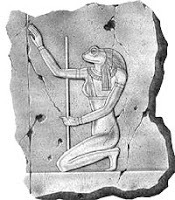 Heket, frog goddessSince frogs lay enormous quantities of eggs, it's only natural that they would become a fertility symbol. The Egyptians depicted the water goddess, Heket, as a frog or as a woman with the head of a frog. She ruled conception and birth, was the goddess of midwifery and protected new-born babies. Egyptian women seeking to conceive often wore amulets which depicted Heket as a frog sitting on a lotus flower. Women in childbirth also wore these amulets. It's interesting that in ancient Mesoamerica, many tribes worshipped a corn goddess who took the form of a frog or a toad with many udders – just like Heket, she was the patron of childbirth and fertility.
Heket, frog goddessSince frogs lay enormous quantities of eggs, it's only natural that they would become a fertility symbol. The Egyptians depicted the water goddess, Heket, as a frog or as a woman with the head of a frog. She ruled conception and birth, was the goddess of midwifery and protected new-born babies. Egyptian women seeking to conceive often wore amulets which depicted Heket as a frog sitting on a lotus flower. Women in childbirth also wore these amulets. It's interesting that in ancient Mesoamerica, many tribes worshipped a corn goddess who took the form of a frog or a toad with many udders – just like Heket, she was the patron of childbirth and fertility.Frogs also became potent symbols of abundance. They appeared in vast numbers during the annual flooding of the Nile and it wasn't long before the Egyptians adopted the frog as their hieroglyph for an immense number – 100,000. In Chinese folklore, it was said that frog spawn fell from heaven, and so frog meat may be still be referred to as "heavenly chicken", especially in rice-growing areas!
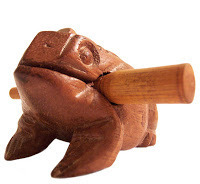 Frog brings fire to humansFrogs and toads have appeared in ancient stories as heroes and benefactors of the human race. In Native American legends of the Southwest, the Frog is usually depicted carrying a piece of wood in its mouth, because the Mojave people believe it was the Frog who brought fire to humans. In some stories, Australia's Aboriginal peoples credited the frog with bringing rain to make the plants grow. In Aztec folklore, the god Quetzacoatl assumed the form of a little blue frog in order to bring "the food of the gods" to humans – cocoa!
Frog brings fire to humansFrogs and toads have appeared in ancient stories as heroes and benefactors of the human race. In Native American legends of the Southwest, the Frog is usually depicted carrying a piece of wood in its mouth, because the Mojave people believe it was the Frog who brought fire to humans. In some stories, Australia's Aboriginal peoples credited the frog with bringing rain to make the plants grow. In Aztec folklore, the god Quetzacoatl assumed the form of a little blue frog in order to bring "the food of the gods" to humans – cocoa!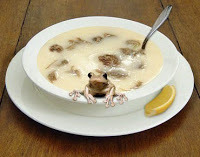 Frog soup?Frogs and toads have often been associated with healing powers. A supposed cure for thrush, sore throat, and colds was holding a live frog with its head in the patient's mouth! As the frog breathed, it was said to draw the illness away from the patient and into itself. Warts were said to be cured by rubbing a frog or toad across them (which is odd, since there are so many old wives tales about frogs and toads causing warts!) Eating frog soup was said to cure whooping cough.
Frog soup?Frogs and toads have often been associated with healing powers. A supposed cure for thrush, sore throat, and colds was holding a live frog with its head in the patient's mouth! As the frog breathed, it was said to draw the illness away from the patient and into itself. Warts were said to be cured by rubbing a frog or toad across them (which is odd, since there are so many old wives tales about frogs and toads causing warts!) Eating frog soup was said to cure whooping cough.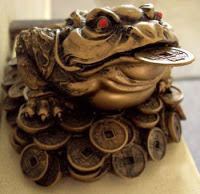 Chan Chu, the money toadBy the way, frogs and toads were usually interchangeable in myth and legend. A three-legged toad named Chan Chu is the traditional pet of the immortal Liu Hai, Chinese god of wealth. The toad is usually pictured with red eyes and a gold coin in its mouth, and is usually sitting on a pile of coins as well. Figurines of Chan Chu are used in the practice of Feng Shui in order to attract wealth both at home and at work. Businesses often keep a statue of Chan Chu near their cash register, and in the home, Chan Chu is never placed facing the door. The frog is to be placed as if he has just entered the home, bringing abundance with him!
Chan Chu, the money toadBy the way, frogs and toads were usually interchangeable in myth and legend. A three-legged toad named Chan Chu is the traditional pet of the immortal Liu Hai, Chinese god of wealth. The toad is usually pictured with red eyes and a gold coin in its mouth, and is usually sitting on a pile of coins as well. Figurines of Chan Chu are used in the practice of Feng Shui in order to attract wealth both at home and at work. Businesses often keep a statue of Chan Chu near their cash register, and in the home, Chan Chu is never placed facing the door. The frog is to be placed as if he has just entered the home, bringing abundance with him!***************************************************
 LEAP INTO BOOKS GIVEAWAY HOP
LEAP INTO BOOKS GIVEAWAY HOPOVER 200 BOOK-RELATED BLOGS ARE PARTICIPATING!!! That means lots of chances for YOU to WIN! Each blog on the list hosts a giveaway and all hosts are linked up so you can HOP from one blog to another! (You don't have to visit them all - each has their own giveaway that is separate from all others.)
 For my giveaway, I'm offering a signed copy of my latest shapeshifter romance, CHANGELING DAWN plus a Dani Harper TOTE BAG to put it in! To enter, leave a comment about frogs or toads. Please include an email address so I can contact you if you win. A name will be drawn at random from comments on March 6! This draw is INTERNATIONAL.
For my giveaway, I'm offering a signed copy of my latest shapeshifter romance, CHANGELING DAWN plus a Dani Harper TOTE BAG to put it in! To enter, leave a comment about frogs or toads. Please include an email address so I can contact you if you win. A name will be drawn at random from comments on March 6! This draw is INTERNATIONAL.Go to THIS LINK: http://iamareadernotawriter.blogspot.com/2012/01/leap-into-books-giveaway-hop-sign-ups.html to get back to the list of participating blogs. Happy hopping and good luck!
Like this post? Please share by clicking one of the links below.
Published on February 28, 2012 14:47
No comments have been added yet.



